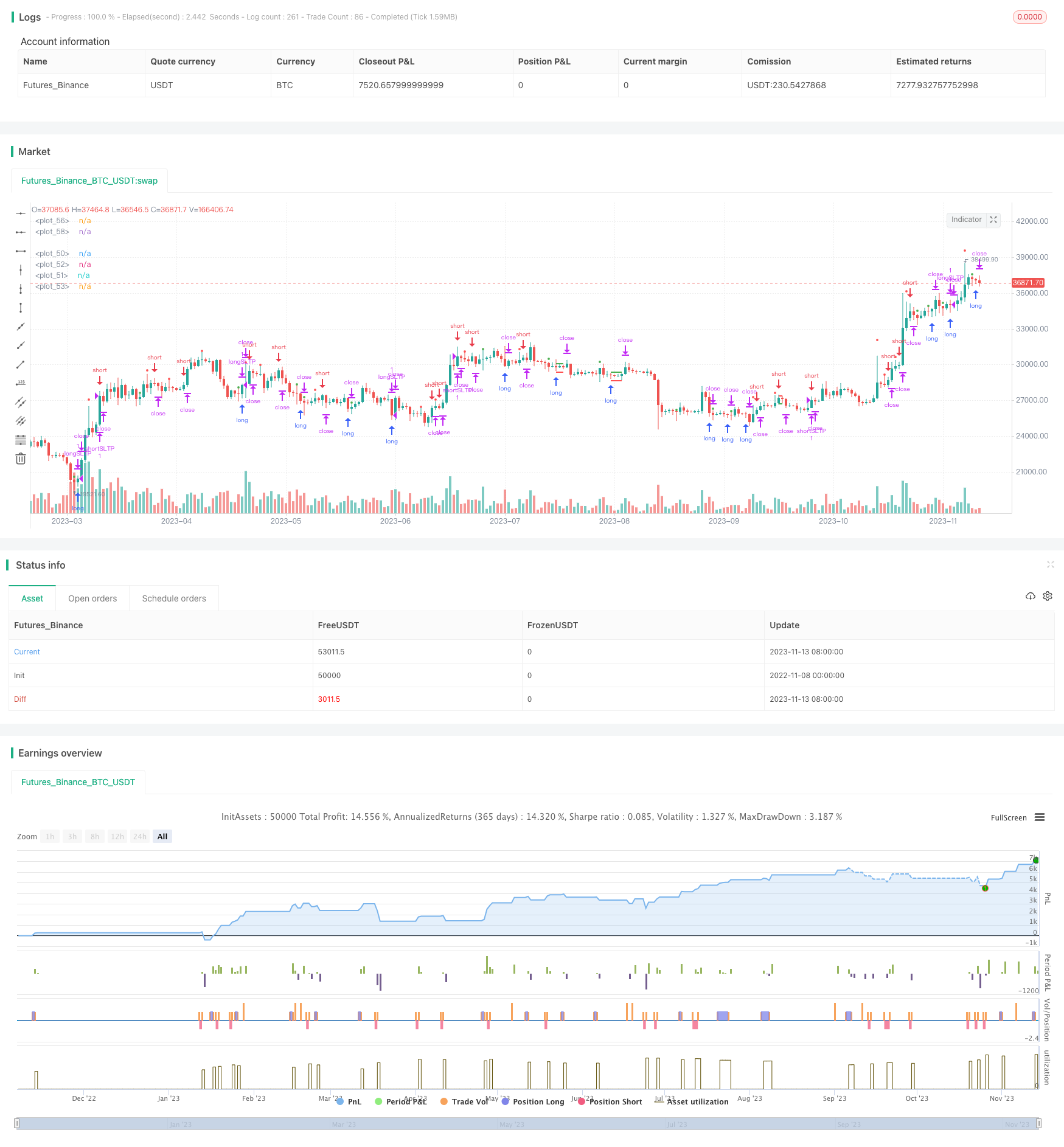
本策略通过计算K线的阳阴影长度比率,判断目前趋势方向,配合平均真实波幅ATR进行趋势识别,在突破点进行反向开仓,设置止损止盈,捕捉短期趋势。
策略原理
该策略主要通过计算K线的阳阴影长度比率,判断目前的趋势方向,当阴线长度过长时判断为向下趋势,当阳线长度过长时判断为向上趋势。
策略具体逻辑是:
- 计算K线的下阴影长度:close-low(收盘价-最低价)
- 计算K线的上阴影长度:high-open(最高价-开盘价)
- 取下阴影和上阴影的最大值作为阴影长度
- 计算K线实体长度:high-low(最高价-最低价)
- 计算阴影长度与实体长度之比
- 当比率大于0.5并且下阴影大于上阴影时,判断为向下趋势,设置多单进场
- 当比率大于0.5并且上阴影大于下阴影时,判断为向上趋势,设置空单进场
- 进场时要同时判断K线实体长度是否大于0.75倍的ATR平均真实波幅,避免无效突破
- 进场后设置止损止盈,止损为入场价乘以系数,止盈为入场价乘以2倍系数,实现盈亏比为2:1
以上就是策略的基本交易逻辑,通过识别趋势突破点进行反向开仓,设置止损止盈后进行盈利优化。
策略优势
- 使用阳阴影比率判断趋势方向,区分度高
- 结合ATR指标进行有效突破判断,避免头假信号
- 设置止损止盈,有利于风险控制
- 实现2:1盈亏比,符合量化交易标准
- 适用于高波动股票的短线交易
- 策略逻辑简单清晰,容易理解实现
策略风险
- 股价剧烈波动时,止损可能被突破,造成损失扩大
- 效果与参数设定密切相关,需要优化参数
- 趋势产生转折时,可能形成损失
- 同步扩大止损和止盈范围会增加亏损概率
- 突破失败时会损失较大资金
可通过合理止损,优化参数,及时止损来控制风险。
策略优化
策略可从以下几个方面进行优化:
- 优化阳阴影比率参数,找出最佳数值
- 优化ATR参数,找出最好的K线长度判定
- 优化止损止盈系数,实现最佳风险收益比
- 增加仓位管理,例如逐步加仓
- 增加跟踪止损,实现盈利保护
- 结合其他指标过滤入场信号
- 优化回测时间段,测试不同市场阶段的效果
通过多方位测试与优化,可将策略效果最大化。
总体来说,该策略通过趋势识别与风险控制的方式,利用短期价格波动获利,是一个效果稳定的短线突破策略。优化后可成为量化交易的关键部分。
策略源码
/*backtest
start: 2022-11-08 00:00:00
end: 2023-11-14 00:00:00
period: 1d
basePeriod: 1h
exchanges: [{"eid":"Futures_Binance","currency":"BTC_USDT"}]
*/
// This source code is subject to the terms of the Mozilla Public License 2.0 at https://mozilla.org/MPL/2.0/
// © ondrej17
//@version=4
strategy("longWickstrategy", overlay=true )
// Inputs
st_yr_inp = input(defval=2020, title='Backtest Start Year')
st_mn_inp = input(defval=01, title='Backtest Start Month')
st_dy_inp = input(defval=01, title='Backtest Start Day')
en_yr_inp = input(defval=2025, title='Backtest End Year')
en_mn_inp = input(defval=01, title='Backtest End Month')
en_dy_inp = input(defval=01, title='Backtest End Day')
sltp_inp = input(defval=0.8, title='N - % offset for N*SL and (2N)*TP')/100
// Dates
start = timestamp(st_yr_inp, st_mn_inp, st_dy_inp,00,00)
end = timestamp(en_yr_inp, en_mn_inp, en_dy_inp,00,00)
canTrade = time >= start and time <= end
// Indicators Setup
// Strategy Calcuations
lowerWick = (open > close) ? close-low : open - low
upperWick = (open > close) ? high-open : high-close
wickLength = max(lowerWick,upperWick)
candleLength = high-low
wickToCandleRatio = wickLength / candleLength
entryFilterCandleLength = candleLength > 0.75*atr(48)
// Entries and Exits
longCondition = entryFilterCandleLength and wickToCandleRatio > 0.5 and lowerWick > upperWick and canTrade and strategy.position_size == 0
shortCondition = entryFilterCandleLength and wickToCandleRatio > 0.5 and lowerWick < upperWick and canTrade and strategy.position_size == 0
strategy.entry("pendingLong", strategy.long, limit=low+wickLength/2, when = longCondition)
strategy.entry("pendingShort", strategy.short, limit=high-wickLength/2, when = shortCondition)
longStop = strategy.position_size > 0 ? strategy.position_avg_price*(1-sltp_inp) : na
longTP = strategy.position_size > 0 ? strategy.position_avg_price*(1+2*sltp_inp) : na
shortStop = strategy.position_size < 0 ? strategy.position_avg_price*(1+sltp_inp) : na
shortTP = strategy.position_size < 0 ? strategy.position_avg_price*(1-2*sltp_inp) : na
strategy.exit("longSLTP","pendingLong", stop=longStop, limit = longTP)
strategy.exit("shortSLTP","pendingShort", stop=shortStop, limit = shortTP)
plot(longStop, color=color.red, style=plot.style_linebr, linewidth=2)
plot(shortStop, color=color.red, style=plot.style_linebr, linewidth=2)
plot(longTP, color=color.green, style=plot.style_linebr, linewidth=2)
plot(shortTP, color=color.green, style=plot.style_linebr, linewidth=2)
plotLongCondition = longCondition ? high+abs(open-close) : na
plot(plotLongCondition, style=plot.style_circles, linewidth=4, color=color.green)
plotShortCondition = shortCondition ? high+abs(open-close) : na
plot(plotShortCondition, style=plot.style_circles, linewidth=4, color=color.red)